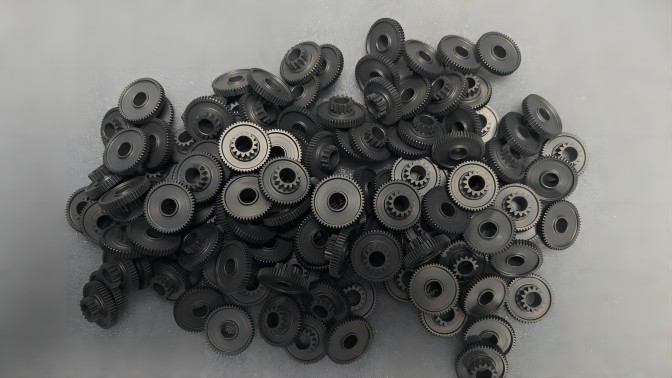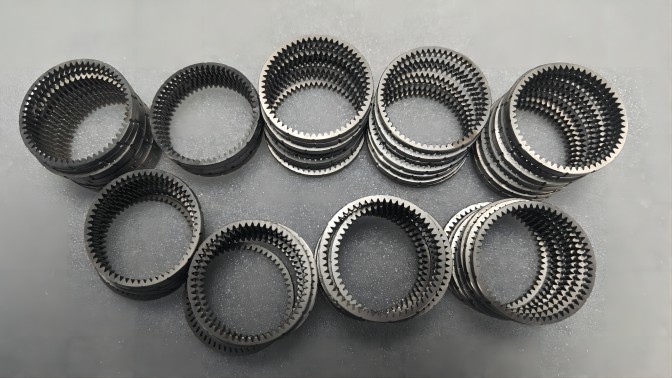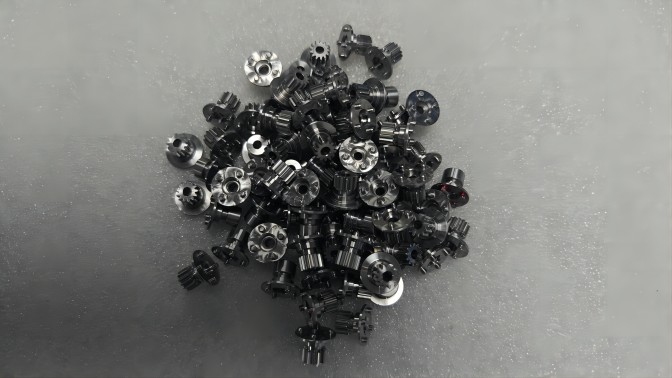We recently made a batch of non-standard gears, mainly used in the field of automation machinery, then do you know what our gear manufacturing steps are? Let me tell you

The production process of gears generally includes the following steps:
1. Design planning:
• Determine parameters: according to the specific requirements of the gear and the working environment, determine the gear transmission ratio, number of teeth, modulus, index circle diameter, tooth width and other parameters. The calculation of these parameters needs to be based on the principle of mechanical transmission and related design formulas, such as determining the transmission ratio through the motion transmission chain, calculating the circumferential force on the gear teeth according to the torque on the pinion, and then calculating the modulus of the gear and the diameter of the index circle by the bending fatigue strength of the gear teeth and the contact fatigue strength of the tooth surface.
• Choice of material: The choice of gear material is critical to the performance and service life of the gear. Common gear materials are medium carbon steel (such as 45 steel), low and medium carbon alloy steel (such as 20Cr, 40Cr, 20CrMnTi, etc.), for important gears with higher requirements, 38CrMoAlA nitride steel can be selected, and non-force transmission gears can also be made of cast iron, plywood or nylon and other materials.
2. Blank preparation:
• Forging: When gears require high strength, wear resistance and impact resistance, forging blanks are usually used. Forging can improve the internal organization of the metal material, make it more dense, and improve the mechanical properties of the gear. The blank after forging needs to be treated with isothermal normalizing to eliminate the residual stress caused by forging and roughing, improve the machinability of the material and improve the comprehensive mechanical properties.
• Casting: For large gears with a diameter greater than 400-600mm, blanks are commonly cast. Casting can produce gears with complex shapes, but the internal organization of the cast gear may have defects such as porosity and porosity, which require subsequent heat treatment and mechanical processing to improve its performance.
• Other methods: For gears of small size and complex shape, new processes such as precision casting, pressure casting, precision forging, powder metallurgy, hot rolling and cold extrusion can be used to produce tooth billet with gear teeth to improve labor productivity and save raw materials.
3. Mechanical processing:
• Tooth blank processing:
• Roughing: rough turning, rough milling and other processing of the tooth blank to remove most of the margin, leaving 0.5-1mm processing margin for subsequent finishing. When roughing, it is necessary to ensure that the dimensional accuracy and surface roughness of the tooth blank meet the design requirements.
• Semi-finishing: semi-finishing turning, semi-finishing milling and other processing, to further improve the dimensional accuracy and surface quality of the tooth blank, to prepare for the tooth shape processing. During semi-finishing, attention should be paid to controlling the uniformity of the processing allowance to avoid excessive or too small allowance.
• Finishing: Fine turning, fine milling, grinding and other processing of the tooth blank to ensure that the dimensional accuracy, shape accuracy and surface roughness of the tooth blank meet the design requirements. When finishing, the appropriate processing technology and tool should be selected to improve the processing efficiency and processing quality.
• Tooth shape processing:
• Milling teeth: The use of disk modulus milling cutter or finger milling cutter milling teeth, belongs to the forming process. The cutter tooth section shape corresponds to the shape of the gear teeth, and the milling teeth can process gears of various shapes, but the processing efficiency and processing accuracy are low, which is suitable for single piece small batch production or repair.
• Hobbing: It belongs to the generating process, and the working principle is equivalent to the meshing of a pair of helical gears. Gear hob prototype is a spiral gear with a large spiral Angle, because the number of teeth is very small (usually the number of teeth), the teeth are very long, around the shaft to form a worm with a small spiral Angle, and then through the slot and the teeth, it becomes a hob with cutting edge and back Angle. Gear hobbing is suitable for all kinds of mass production, processing medium quality external cylindrical gear and worm gear.
• Gear shaper: It is also a kind of developing method processing. When gear shaper is used, the gear shaper cutter and the workpiece are equivalent to the meshing of a pair of cylindrical gears. The reciprocating motion of the gear shaper is the main motion of the gear shaper, and the circular motion made by the gear shaper and the workpiece according to a certain proportion is the feed motion of the gear shaper. Gear shaper is suitable for all kinds of mass production, processing medium quality internal and external cylindrical gears, multi-coupling gears and small rack.
Shaving: Shaving is a commonly used finishing method for unhardened tooth surfaces in mass production. The working principle is to use the shaving cutter and the gear to be processed for free meshing movement, with the help of the relative slip between the two, to shave very fine chips from the tooth surface to improve the accuracy of the tooth surface. The shaving teeth can also form drum teeth to improve the position of the contact area of the tooth surface.
Gear grinding: is a method of tooth profile finishing, especially for hardened gears, often the only finishing method. Gear grinding can be grinding with worm grinding wheel, also can be grinding with conical grinding wheel or disc grinding wheel. Gear grinding machining precision is high, surface roughness value is small, but the production efficiency is low, high cost.

4. Heat treatment:
• Blank heat treatment: Arrange pre-heat treatment before and after the tooth blank processing, such as normalizing or tempering, the main purpose is to eliminate the residual stress caused by forging and roughing, improve the machinability of the material and improve the comprehensive mechanical properties.
• Heat treatment of the tooth surface: After the tooth shape processing, in order to improve the hardness and wear resistance of the tooth surface, carburizing hardening, high-frequency induction heating hardening, carbonitriding and nitriding heat treatment processes are often carried out.
5. Tooth end processing: the tooth end of the gear is processed by rounding, chamfering, chamfering and deburring. Tooth end machining must be carried out before the gear quenching, usually after rolling (interpolation) teeth, before shaving arranged tooth end machining.
6. Quality inspection: the various parameters of the gear are tested, such as tooth shape, tooth pitch, tooth direction, tooth thickness, common normal length, runout, etc., to ensure that the precision and quality of the gear meet the design requirements. The detection methods include manual measurement with measuring tools and precision measurement with gear measuring instruments.

Post time: Nov-01-2024
